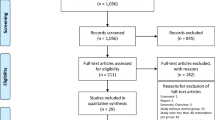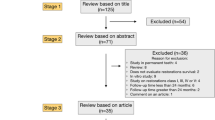Abstract
Purpose
The aim of this systematic review was to compare the success rate of five tooth-coloured materials, namely Glass Ionomer (GI), Resin-Modified Glass Ionomer (RMGI), Composite Resin (CR), Polyacid-Modified Composite Resin or Compomer (CO) and High-Viscosity Glass Ionomer (HVGI) in primary molar Class II restorations.
Methods
Five databases were searched from inception to April 23, 2020 for randomized clinical trials comparing the failure rate of these materials. After duplicate study removal, data extraction and risk of bias assessment with the Cochrane tool, data synthesis was conducted, comparing all five tooth-coloured materials in pairs and computing the overall success rate for each one, respectively.
Results
A total of 5615 articles were obtained by electronic and hand literature search. After the application of the eligibility criteria, ten RCTs were included in this systematic review and six RCTs for meta-analysis. Their risk of bias was assessed to be high to moderate. Due to the small number of RCTs comparing the five restorative materials in pairs investigated in the same study, only three MAs were available for heterogeneity assessment. These were: (1) between CO-RMGI (RR 1.04 [0.59, 1.84]; p = 0.88; I2 = 1%), (2) CR-CO (RR 1.12 [0.41, 3.02]; p = 0.83; I2 = 57%), and (3) between CR-RMGI (RR 1.10 [0.74, 1.63]; p = 0.65; I2 = 0%). No statistically significant differences were found between the two materials in all three comparisons.
Conclusion
CR, RMGI and CO presented no statistical differences. In comparison to other tooth-coloured materials, studies on GI were too few to allow recommendations about its use. More studies on HGVI are needed for evidence-based recommendations to be made. The evidence extracted from this meta-analysis was not strong enough (moderate), due to the small number of RCTs and the risk of bias ranging from high to moderate. More, well-designed RCTs comparing tooth-coloured materials for primary molar Class II restorations are necessary.








Similar content being viewed by others
Change history
02 November 2021
A Correction to this paper has been published: https://doi.org/10.1007/s40368-021-00678-3
Notes
See also the supplementary material.
References
American Academy of Paediatrics Dentistry (AAPD). Guidelines for Paediatric Restorative Dentistry. Revised 2016. https://www.aapd.org/research/oral-health-policies- recommendations/pediatric-restorative-dentistry/
Algera TJ, Kleverlaan CJ, de Gee AJ, Prahl-Andersen B, Feilzer AJ. The influence of accelerating the setting rate by ultrasound or heat on the bond strength of glass ionomers used as orthodontic bracket cements. Eur J Orthod. 2005;27(5):472–6.
Andersson-Wenckert I, Sunnegardh-Gronberg K. Flowable resin composite as a class II restorative in primary molars: a two-year clinical evaluation. Acta Odontol Scand. 2006;64(6):334–40.
Bektas Donmez S, Uysal S, Dolgun A, Turgut MD. Clinical performance of aesthetic restorative materials in primary teeth according to the FDI criteria. Eur J Paediatr Dent. 2016;17(3):202–12.
Cappelleri JC, Ioannidis JP, Schmid CH, de Ferranti SD, Aubert M, Chalmers TC, Lau J. Large trials vs meta-analysis of smaller trials: how do their results compare? JAMA. 1996;276:1332–8.
Casagrande L, Dalpian DM, Ardenghi TM, Zanatta FB, Balbinot CE, Garcia- Godoy F, et al. Randomized clinical trial of adhesive restorations in primary molars. 18-month results. Am J Dent. 2013;26(6):351–5.
Chadwick BL, Evans DJP. Restoration of class II cavities in primary molar teeth with conventionaland resin modified glass ionomer cements: a systematic review of the literature. Eur Arc Pediatr Dent. 2007;8(1):14–21.
Chisini LA, Collares K, Cademartori MG, de Oliveira LJC, Conde MCM, Demarco FF, Corrêa MB. Restorations in primary teeth: a systematic review on survival and reasons for failures. Int J Paediatr Dent. 2018;28(2):123–39.
Cho SY, Cheng AC. A review of glass ionomer restorations in the primary dentition. J Can Dent Assoc. 1999;65(9):491–5.
Daou MH, Attin T, Göhring TN. Clinical success of compomer and amalgam restorations in primary molars: Follow up in 36 months. Schweiz Monatsschr Zahnmed. 2009;119(11):1082–8.
De Gee AJ, van Duinen RN, Werner A, Davidson CL. Early and longterm wear of conventional and resin-modifies glass ionomers. J Dent Res. 1996;75(8):1613–9.
Dermata A, Papageorgiou SN, Fragkou S, Kotsanos N. Comparison of resin modified glass ionomer cement and composite resin in class II primary molar restorations: a 2-year parallel randomised clinical trial. Eur Arch Paediatr Dent. 2018;19(6):393–401.
Dias AGA, Magno MB, Delbem ACB, Cunha RF, Maia LC, Pessan JP. Clinical performance of glass ionomer cement and composite resin in Class II restorations in primary teeth: A systematic review and meta-analysis. J Dent. 2018;73:1–13.
Ertugrul F, Cogulu D, Ozdemir Y, Ersin N. Comparison of conventional versus colored compomers for Class II restorations in primary molars: a 12-month clinical study. Med Princ Pract. 2010;19(2):148–52.
Frankenberger R, Sindel J, Kramer N. Viscous glass-ionomer cements: a new alternative to amalgam in the primary dentition? Quintessence Int. 1997;28(10):667–76.
Fuks AB, Araujo FB, Osorio LB, Hadani PE, Pinto AS. Clinical and radiographic assessment of Class II esthetic restorations in primary molars. Pediatr Dent. 2000;22(5):479–85.
Gross LC, Griffen AL, Casamassimo PS. Compomers as class II restorations in primary molars. Pediatr Dent. 2001;23(1):24–7.
Guyatt GH, Oxman AD, Schunemann HJ, Tugwell P, Knottnerus A. GRADE guidelines: a new series of articles in the Journal of Clinical Epidemiology. J Clin Epidemiol. 2011;64:380–2.
Higgins JPT, Green S. Cochrane handbook for systematic reviews of interventions version 5.1.0, The Cochrane Collaboration, London, UK. http://handbook.cochrane.org. 2011.
Hübel S, Mejàre I. Conventional versus resin-modified glass-ionomer cement for class II restorations in primary molars. A 3-year clinical study. Int J Paediatr Dent. 2003;13(1):2–8.
Higgins, Julian PT, James Thomas, Jacqueline Chandler, Miranda Cumpston, Tianjing Li, Matthew J. Page, and Vivian A. Welch, editors. Cochrane handbook for systematic reviews of interventions. John Wiley & Sons, 2019.
Kleverlaan CJ, van Duinen RN, Feilzer AJ. Mechanical properties of glass ionomer cements affected by curing methods. Dent Mater. 2004;20(1):45–50.
Krejci I, Gebauer L, Hausler T, Lutz F. Composite polymers: an amalgam substitute for deciduous tooth cavities? Schweiz Monatsschr Zahnmed. 1994;104:724–30.
Kupietzky A, Atia Joachim D, Tal E, Moskovitz M. Long-term clinical performance of heat-cured high-viscosity glass ionomer class II restorations versus resin-based composites in primary molars: a randomized comparison trial. Eur Arch Paediatr Dent. 2019;20(5):451–6.
Liberati A, Altman DG, Tetzlaff J, Mulrow C, Gøtzsche PC, Ioannidis JP, et al. The PRISMA statement for reporting systematic reviews and meta-analyses of studies that evaluate health care interventions: explanation and elaboration. J Clin Epidemiol. 2009;62(10):e1–34.
Menne-Happ U, Ilie N. Effect of heat application on the mechanical behaviour of glass ionomer cements. Clin Oral Investig. 2014;18(2):643–50.
Mufti AS. Clinical efficacy of the conventional glass ionomer cement and resin modified glass ionomer cement in primary molars. J Ayub Med Coll Abbottabad. 2014;26(4):587–90.
Opdam NJ, Bronkhorst EM, Loomans BA, Huysmans MC. 12-year survival of composite vs. amalgam restorations. J Dent Res. 2010;89(10):1063–7.
Osborne JW, Albino JE. Psychological and medical effects of mercury intake from dental amalgam: a status report from the American Journal of Dentistry. Am J Dent. 1999;12:151–6.
Ostlund J, Moller K, Koch G. Amalgam, composite resin and glass ionomer cement in Class II restorations in primary molars—a three-year clinical evaluation. Swed Dent J. 1992;16:81–6.
Qvist V, Laurberg L, Poulsen A, Teglers PT. Longevity and cariostatic effects of everyday conventional glass-ionomer and amalgam restorations in primary teeth: three-year results. J Dent Res. 1997;76:1387–96.
Rutar J, McAllan L, Tyas MJ. Clinical evaluation of a glass ionomer cement in primary molars. Pediatr Dent. 2000;22(6):486–8.
Santos MPA, Luiz RR, Maia LC. Randomised trial of resin-based restorations in Class I and Class II beveled preparations in primary molars: 48-month results. J Dent. 2010;38(6):451–9.
Savovic J, Turner RM, Mawdsley D, Jones HE, Beynon R, Higgins JPT, Sterne JAC. Association between risk-of-Bias assessments and results of randomized trials in Cochrane Reviews: The ROBES Meta-Epidemiologic Study. Am J Epidemiol. 2018;187:1113–22.
Sengul F, Gurbuz T. Clinical evaluation of restorative materials in primary teeth class II lesions. J Clin Pediatr Dent. 2015;39(4):315–21.
Tal E, Kupietzky A, Fuks AB, Tickotsky N, Moskovitz M. Clinical performance of heat-cured high-viscosity glass ionomer class II restorations in primary molars: a preliminary study. J Clin Pediatr Dent. 2017;41(4):264–70.
Toh SL, Messer LB. Toh Messer 2007 Evidence-based assessment of tooth-colored restorations in proximal lesions of primary molars. Pediatr Dent. 2007;29(1):8–15.
Review Manager (RevMan). Version 4.2 for Windows. Oxford, England: The Cochrane Collaboration, 2014.
Wang C, Li H, Yuan MC, Wong J, Zou ZS, et al. Rubber dam isolation for restorative treatment in dental patients. Rev Cochrane Database Syst. 2016. https://doi.org/10.1002/14651858.CD009858.pub2.
Welbury RR, Shaw AJ, Murray JJ, Gordon PH, McCabe JF. Clinical evaluation of paired compomer and glass ion-omer restorations in primary molars: final results after 42 months. Br Dent J. 2000;189(2):93–7.
Wilson AD, Kent BE. A new transluscent cement for dentistry. The glass ionomer cement. Br Dent J. 1972;132(4):133–5.
Yap AU, Pek YS, Cheang P. Physico-mechanical properties of a fast-set highly viscous GIC restorative. J Oral Rehabil. 2003;30(1):1–8.
Author information
Authors and Affiliations
Corresponding author
Additional information
Publisher's Note
Springer Nature remains neutral with regard to jurisdictional claims in published maps and institutional affiliations.
Supplementary Information
Below is the link to the electronic supplementary material.
Appendix
Rights and permissions
About this article
Cite this article
Siokis, V., Michailidis, T. & Kotsanos, N. Tooth-coloured materials for class II restorations in primary molars: systematic review and meta-analysis. Eur Arch Paediatr Dent 22, 1003–1013 (2021). https://doi.org/10.1007/s40368-021-00632-3
Received:
Accepted:
Published:
Issue Date:
DOI: https://doi.org/10.1007/s40368-021-00632-3




